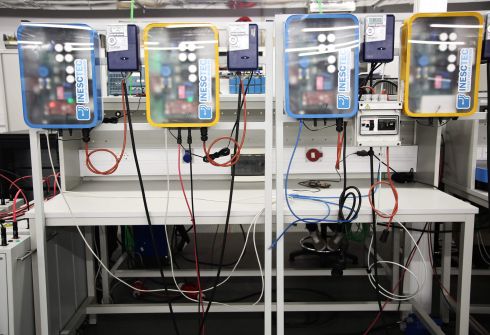
Laboratory of Smart Grids and Electric Vehicles celebrates ten years of innovation in energy
#Smart Grids
29 December 2020
It all started in 2010, in a room at the Faculty of Engineering of the University of Porto. However, the construction work of today’s SGEVL facilities only started in 2011; the official inauguration took place on December 2012.
After a decade, the SGEVL comprehends more than 81 publications and six patent applications. It hosted 10 national and European projects, with a total investment of over €8M, and supported nine PhD theses. 36 researchers, from 10 different countries, worked at the Laboratory. On balance, in 10 years, the SGEVL generated close to 115.48MWh of energy from PV panels installed on the rooftop of the building, and protected the environment by saving 81.6tonnes of CO2.
João Peças Lopes, Associate Director of INESC TEC, was one of the founders of the Laboratory; he said that the dream of the Laboratory, originated about 20 years ago, “is completely surpassed by reality, which is much better”. Concerning the now existing infrastructures, João Peças Lopes highlights the flexibility, “which enables a significant number of tests, serving the industry, while continuing to grow and perform new things”, namely thanks to the academia, with people bringing new concepts and ideas that are then developed and tested.
There are many projects that are worth highlighting – MICROGRIDS, MORE MICROGRIDS, SUSTAINABLE or SENSIBLE, as well as key partners, with whom the team had “the pleasure and the ability” to associate itself with, such as EDP or EFACEC.
Innovation looking towards the future
The history of the Laboratory of Smart Grids and Electric Vehicles is a work in progress, developed over the years by dozens of researchers who have worked there; it is far from over, especially now that the future promises deep changes in terms of the management models of power grids.
Luís Seca, member of the Board of Directors of INESC TEC, and one of the researchers part of the first team of the Laboratory, perceives the recently implemented measures at European and global levels (e.g., the Paris agreements and ratifications) as endless opportunities for the to consolidate the Laboratory’s leading role in energy innovation.
With more and more devices and equipment requesting energy from the power grid, which now needs to address a greater demand, consumers will put pressure on an infrastructure where, until now “consumer behaviour was very passive, with very stable load profiles”. According to Luís Seca, the new paradigm presents “great needs for prediction and handling large volumes of data”, but, even more than that, it shall consider “people’s preferences and the way they are willing to change their behaviours, based on different business models”.
“This demand flexibility is a crucial element to all this, but it requires having someone managing it”, he explained. This is where the Smart Grids Laboratory comes in: demonstrating “disruptive concepts that will later be replicated as projects and direct solutions for companies”. This way, the future of energy “will never compromise the key objective: we all want to arrive home, flick the switch, and see lights turn on”.
The celebrations of the 10th anniversary of the Laboratory of Smart Grids and Electric Vehicles included a debate, focused on the future of V2G. The event included, as main guests, João Torres (CEO of EDP Distribuição), Nuno Silva (CTO and member of the Board of Directors of EFACEC group) and Nikos Hatziargyriou (Vice President of ETIP-SNET). João Peças Lopes represented the Laboratory, with Luís Seca as moderator.
The new energy paradigm and its impact on the management of power grids networks were the starting point for the discussion, with João Peças Lopes advocating electric vehicles as the potential solution to the challenges of the massification of PV power generation: during the day, they store the energy produced, and overnight, they support operators addressing peak demand. More than that, electric vehicles can benefit from inverters to control the voltage – which is also an increasing challenge.
João Torres shared the vision of João Peças Lopes, but admits that innovation in V2G “is still in an early stage”, and that “greater collaboration from consumers” is needed. Nuno Silva, on the other hand, pointed out that “regulation also needs to become smart”.
Despite all these scenarios, Nikos Hatziargyriou highlighted the “prominent role” of the Laboratory in the development of “innovative and efficient” solutions, in partnership with the industry.
The INESC TEC researchers mentioned in this news piece are associated with UP-FEUP.
